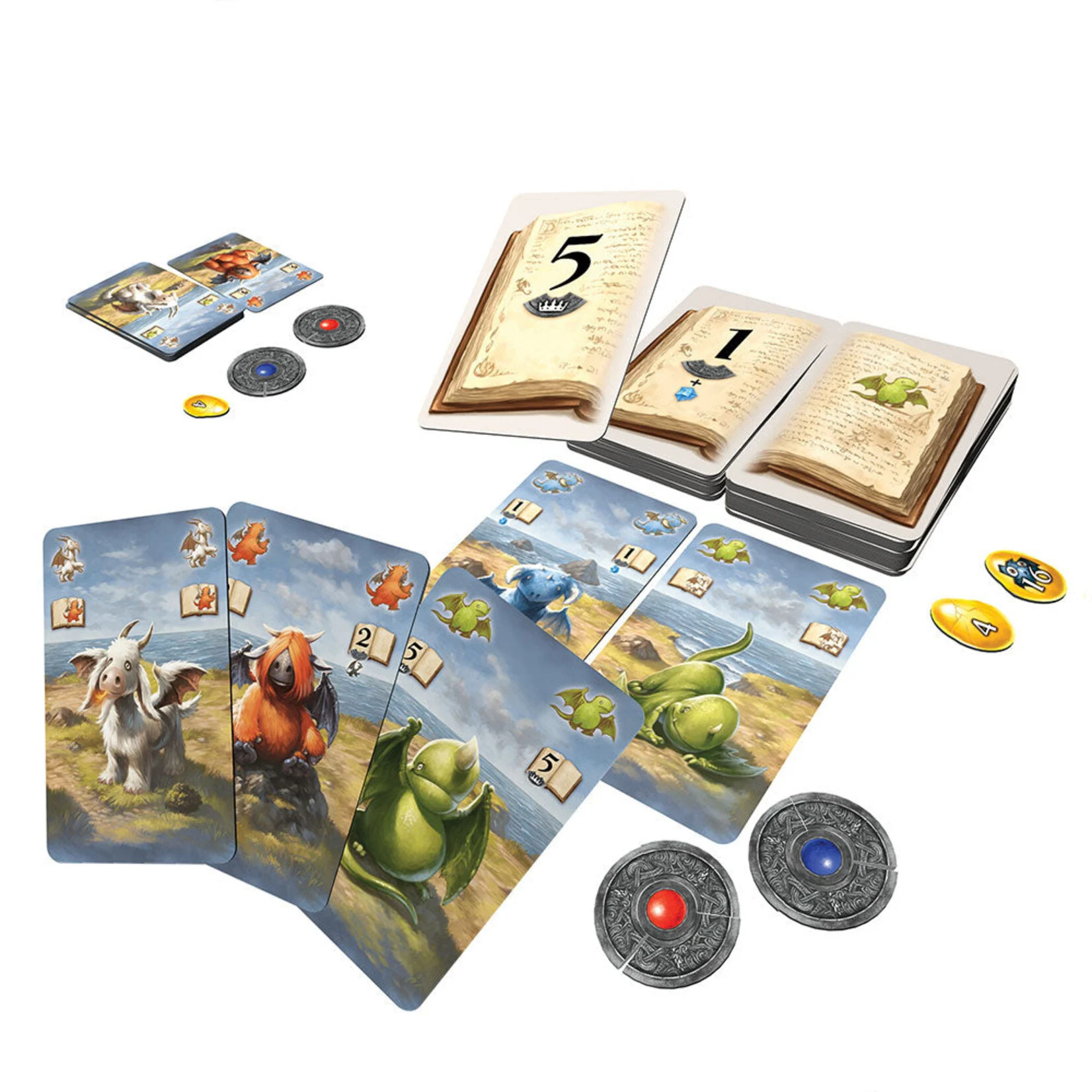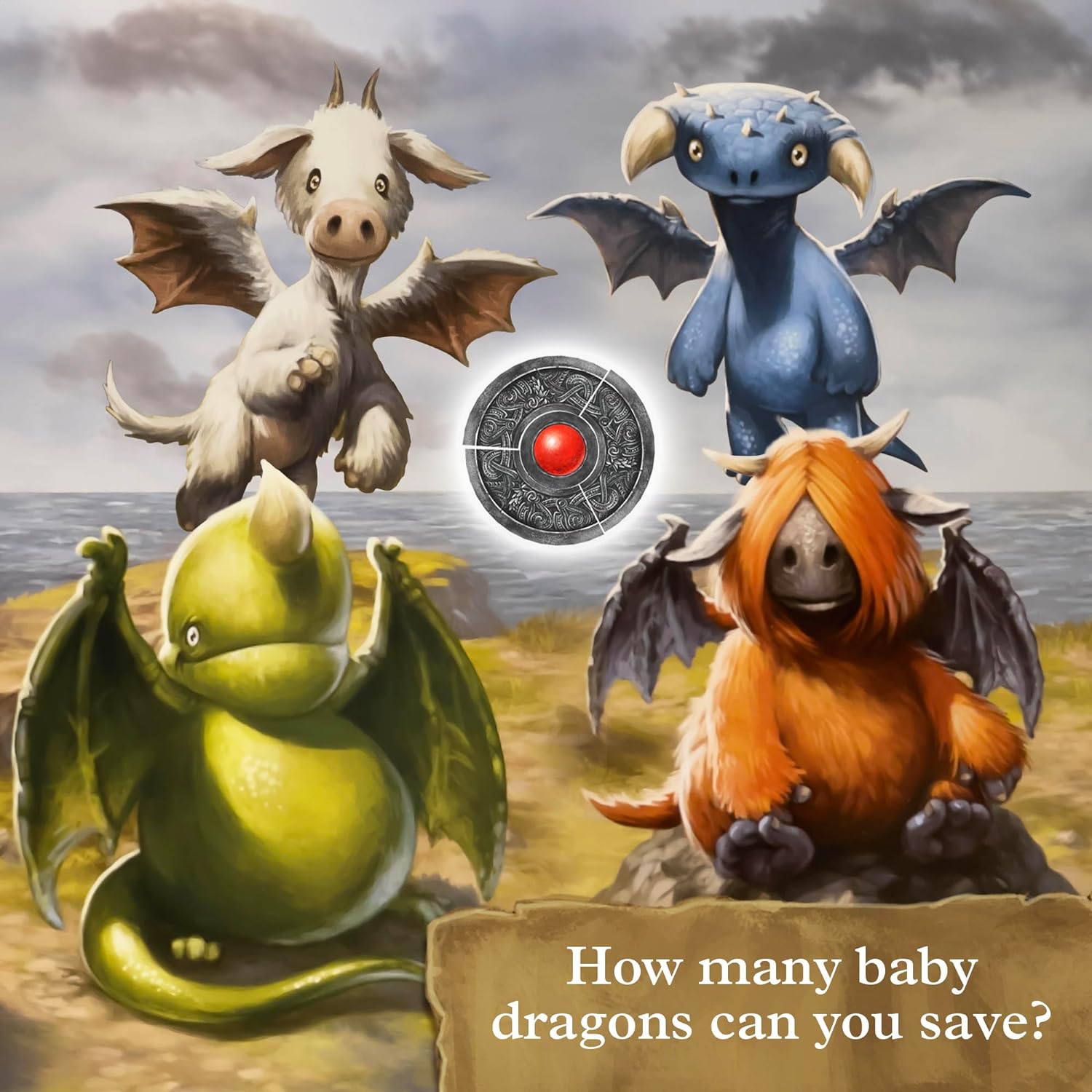As The Fandomentals’ resident dragon lover, I obviously had to play Dragonkeepers from Thames and Kosmos and designer and illustrator Michael Menzel. For two to four players, the game challenges you to get the most points by acquiring and playing dragons, all while keeping track of the magic book and which dragons are already in play. With unique art and fun gameplay, Dragonkeepers is perfect for anyone who likes card games and hand building.
What’s in the box?

Dragonkeepers comes with six magic chests (used after you’ve played the game a few times), 8 starting cards, 11 shadow dragons, 104 cards with blue, green, white, and red dragons, 45 amulet pieces, 3 crests, 9 golden eggs, 15 pearls, and 10 crystals. Like every game that I’ve played from Thames and Kosmos, the quality of the cards and pieces are really solid. I was particularly pleased that the amulet pieces and pearls were cut together so that when you’re done building one, everything slots together nicely.
It’s something small but really shows the care that the team put into creating the die cuts for all the pieces. The box also had a little pop out to hold the cards in place so I didn’t have to rubber band them or anything. Grabbing two rubber bands would have been easy, but I love when game boxes are actually meant to truly hold everything in place. All I had to do was grab a baggie for the amulet pieces so they wouldn’t go all over the place when storing the box.
How’s it play?
Gameplay in Dragonkeepers is pretty simple. The challenge is in keeping track of what cards you have, when you can play them, and how you’ve been scoring throughout the game. For set up, the 11 shadow dragons and 8 starting cards are put as separate stacks. The first player doesn’t get any starting cards, but each player after them gets one, two, or three cards depending on the number of players in the game.
The remaining 104 dragon cards are shuffled and placed in two stacks to form the magic book. Numbered cards on the left, and dragon facing cards on the right. The display is one face up card from each stack in the front. Finally place the number of amulet pieces depending on the number of players on the left sorted by their values next to the crests, eggs, pearls, and crystals. You’re all set up!

On each player’s turn, you have three actions that you can do. First, you can take 1, 2, or 3 cards one at a time from the display. Then you can change the magic book using a card in your hand to change either the number or the color of the dragon so that you can play the number of dragons in your hand that you want to play. Then you play the exact number of cards in that color in front of you.
However! No card may be placed on top of a stack that is between two other dragon colors, which forces players to really think about which colored dragon they want to be focused on getting and playing. Fortunately you can use the other side of the dragons you don’t want to change the magic book as needed.
The next player then can place cards if they can fulfill the requirements of the magic book before they take cards from the display.
When placing dragons, you get whatever the reward is on the numbered card. Usually this is an amulet piece (of the lowest available value) with or without a crystal. When playing four or more dragons you can get an egg, and if you play six of a dragon you get the highest available amulet piece.
Whoever places all four colors of the dragons first gets the highest valued crest and then remaining players (if they place all four) get whatever crest is left.
Dragonkeepers ends when there are seven complete amulets among all the players, and whoever has the highest score wins!
The verdict?
My friend and I played through Dragonkeepers a number of times and had so much fun! Once we got through our first play, the games went by really fast and we were deep in the strategizing mode. Amulet pieces are laid face down so you can’t mentally keep track of your score as you go, but if you paid attention to when you were getting amulets and especially as the amulets dwindle throughout the game, you have a general idea of how you are doing.
This means that you can choose to go one of two ways. You can play dragons as many times as you absolutely can just to score amulet pieces first (and if possible, the red pearls which are higher points and of course a golden egg worth 16 points). Or you can hold onto your dragons for as long as possible and then try to play six at a time with or without the help of the shadow dragons which can be any color when you play them.

I uh, went with the second option and because of this was able to get the highest scoring amulets multiple times, which made it impossible for my friend to catch up. This does of course require you to be able to get the dragons in the first place so definitely shuffle that deck!
It was also fun trying to figure out whether we should actually play all four colors of dragons or just stick with two until most of one color was gone and then play a new color. The first game my friend and I just tacitly agreed to stick to two colors and then once one was almost done (at some point there just won’t be any in the deck), we switched to other colors.
Dragonkeepers is a lot of fun, accessible for newer gamers and families, but still fun for seasoned board game players!
You can get the game from Thames and Kosmos directly or your FLGS!
Images and review copy courtesy of Thames and Kosmos
Have strong thoughts about this piece you need to share? Or maybe there’s something else on your mind you’re wanting to talk about with fellow Fandomentals? Head on over to our Community server to join in the conversation!

